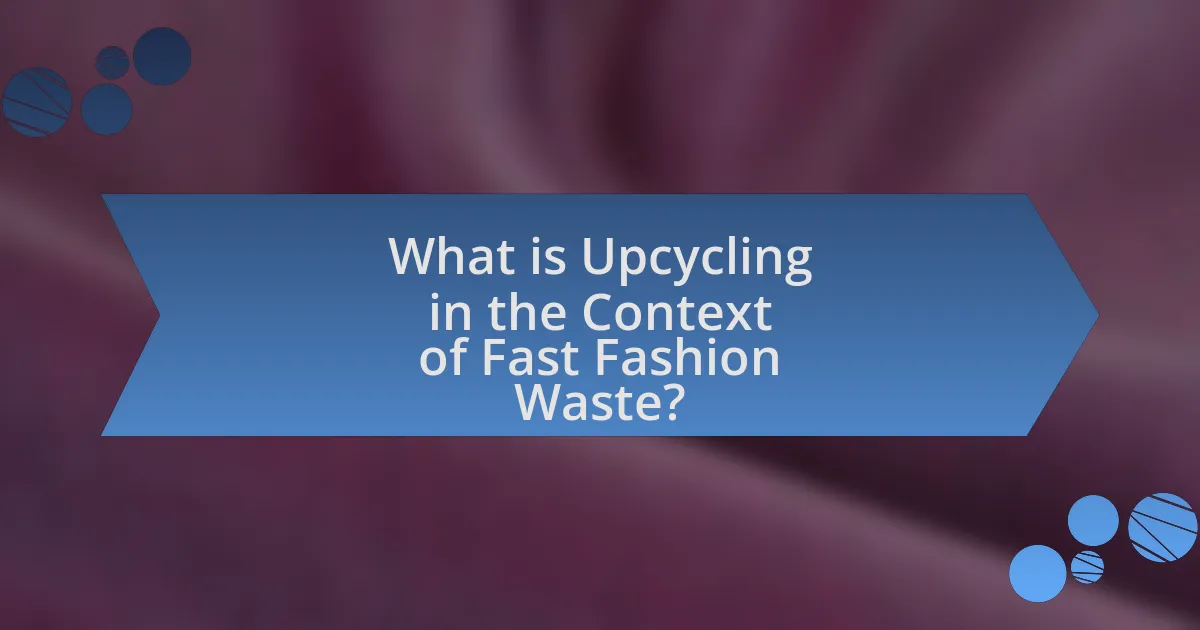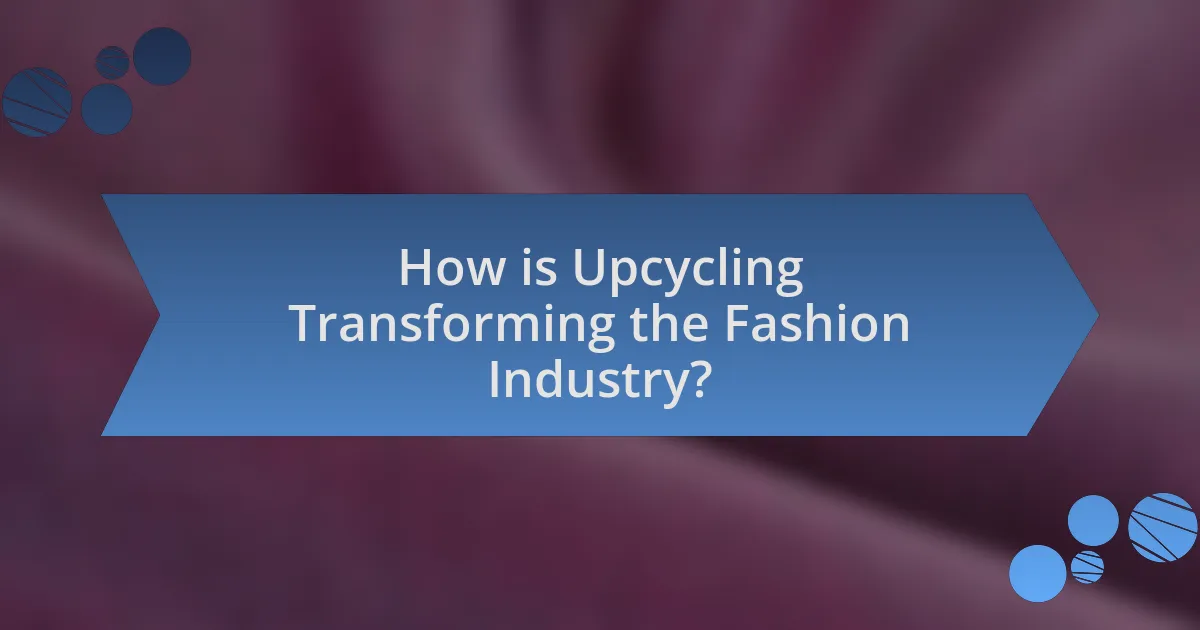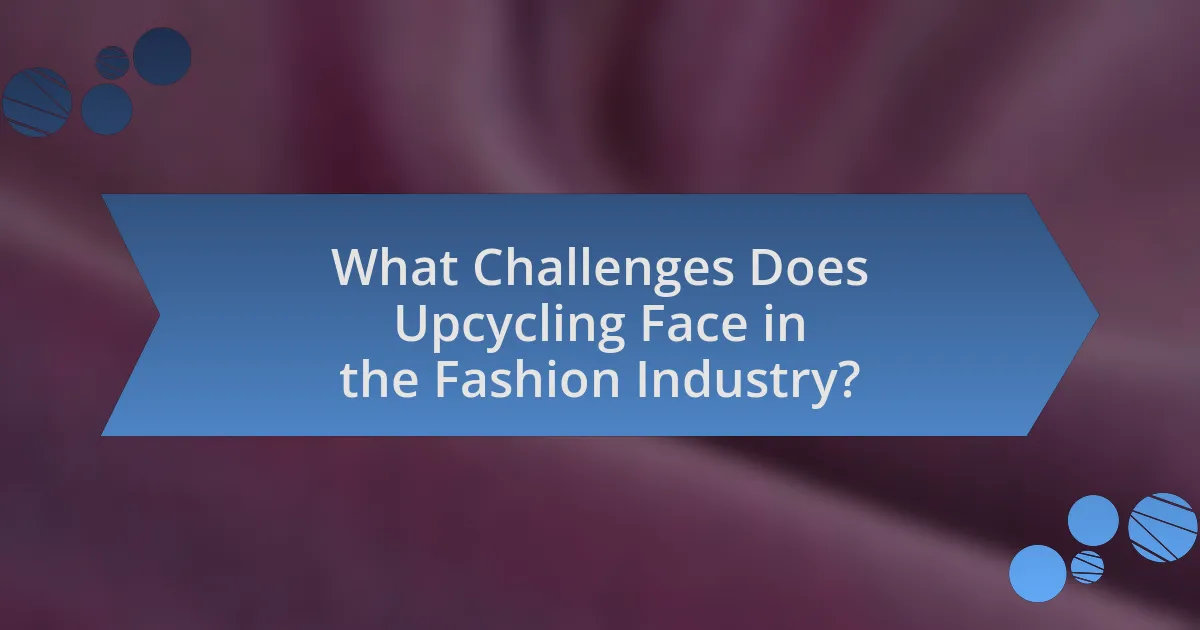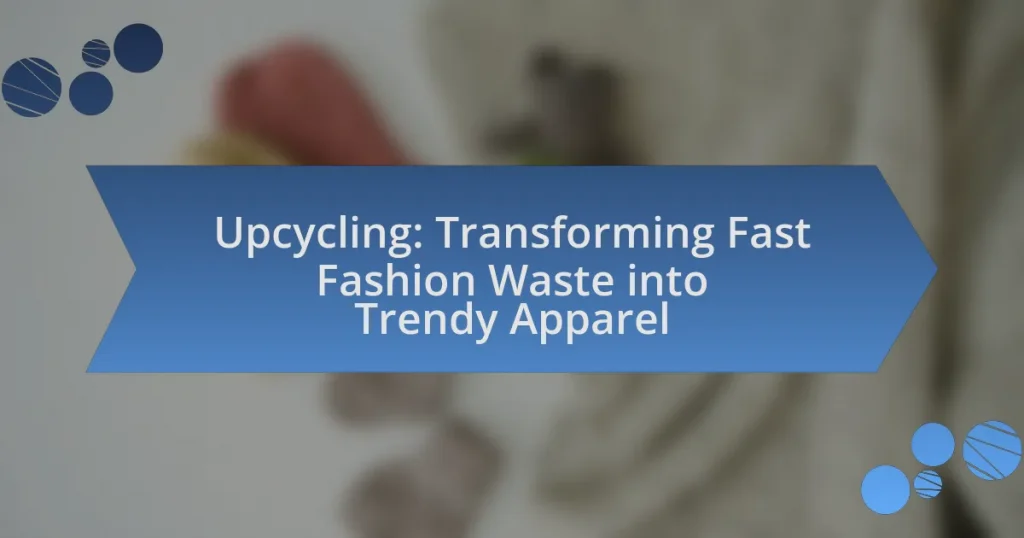Upcycling is the process of creatively reusing discarded clothing and materials to produce new, higher-value products, addressing the significant textile waste generated by the fast fashion industry, which produces over 92 million tons of waste annually. This practice not only reduces landfill contributions but also promotes sustainability and a circular economy by transforming materials into fashionable items. The article explores the differences between upcycling and recycling, the processes involved in upcycling fast fashion waste, the types of materials commonly used, and the environmental benefits associated with this practice. Additionally, it discusses emerging trends in upcycled fashion, successful brands, consumer awareness, and the challenges faced in mainstream acceptance, providing a comprehensive overview of how upcycling is reshaping the fashion industry.

What is Upcycling in the Context of Fast Fashion Waste?
Upcycling in the context of fast fashion waste refers to the process of creatively reusing discarded clothing and materials to create new, higher-value products. This practice addresses the environmental impact of fast fashion, which generates significant textile waste; for instance, the Ellen MacArthur Foundation reports that over 92 million tons of textile waste are produced globally each year. By transforming these materials into fashionable items, upcycling not only reduces waste but also promotes sustainability and encourages a circular economy in the fashion industry.
How does upcycling differ from recycling?
Upcycling differs from recycling in that upcycling involves creatively repurposing materials into new products of higher value, while recycling breaks down materials to create new raw materials. Upcycling enhances the original item’s value through artistic or functional transformation, such as turning old clothing into fashionable accessories. In contrast, recycling typically involves a mechanical or chemical process that reduces items to their base materials, which can then be remade into new products, often of lower quality. For example, recycling plastic bottles into fibers for clothing results in a product that may not retain the original quality of the bottles.
What processes are involved in upcycling fast fashion waste?
Upcycling fast fashion waste involves several key processes: collection, sorting, deconstruction, redesign, and production. Initially, waste materials are collected from various sources, including unsold inventory and discarded garments. Following collection, the materials are sorted based on fabric type, condition, and potential for reuse. Deconstruction then takes place, where garments are dismantled to retrieve usable components such as fabric, buttons, and zippers.
Next, the sorted and deconstructed materials are redesigned into new products, which may include clothing, accessories, or home goods. Finally, the redesigned items are produced, often incorporating sustainable practices to minimize environmental impact. This process not only reduces waste but also promotes creativity and sustainability in the fashion industry.
Why is upcycling considered a sustainable practice?
Upcycling is considered a sustainable practice because it reduces waste by repurposing materials that would otherwise be discarded. This process minimizes the demand for new resources, thereby lowering the environmental impact associated with production and disposal. For instance, according to a report by the Ellen MacArthur Foundation, upcycling can significantly decrease landfill contributions and reduce carbon emissions, as it often requires less energy than creating new products from raw materials.
What types of materials can be upcycled from fast fashion waste?
Various materials can be upcycled from fast fashion waste, including cotton, polyester, denim, and leather. Cotton can be repurposed into new garments or accessories, while polyester, often derived from plastic bottles, can be transformed into insulation or new fabric. Denim can be creatively altered into bags or home decor items, and leather scraps can be used for smaller products like wallets or keychains. The potential for upcycling these materials is significant, as the global fashion industry generates over 92 million tons of textile waste annually, highlighting the need for sustainable practices.
Which fabrics are most commonly upcycled?
Denim, cotton, and polyester are the fabrics most commonly upcycled. Denim is frequently repurposed due to its durability and popularity in fashion, while cotton is often upcycled because of its widespread use in clothing and home textiles. Polyester, being a synthetic fabric, is also commonly recycled, especially from plastic bottles, as it can be transformed into new garments. According to the Ellen MacArthur Foundation, upcycling these materials helps reduce waste and promotes sustainability in the fashion industry.
How can accessories and other items be created from upcycled materials?
Accessories and other items can be created from upcycled materials by repurposing discarded textiles, plastics, and other waste into new products. For instance, old clothing can be transformed into bags, jewelry, or home decor by cutting, sewing, or weaving the materials. This process not only reduces waste but also promotes sustainability in fashion. According to a report by the Ellen MacArthur Foundation, upcycling can significantly decrease the environmental impact of the fashion industry by extending the lifecycle of materials and reducing the need for new resources.
What are the environmental impacts of upcycling fast fashion waste?
Upcycling fast fashion waste significantly reduces environmental impacts by minimizing landfill contributions and lowering resource consumption. This process diverts textiles from landfills, where they would otherwise contribute to methane emissions, a potent greenhouse gas. According to the Environmental Protection Agency, textiles account for about 9.2 million tons of waste in the U.S. alone, highlighting the importance of upcycling in waste reduction. Additionally, upcycling decreases the demand for new materials, which in turn conserves water and energy resources; for instance, producing a single cotton t-shirt requires approximately 2,700 liters of water. By transforming discarded garments into new products, upcycling not only mitigates waste but also promotes sustainable practices within the fashion industry.
How does upcycling reduce landfill waste?
Upcycling reduces landfill waste by transforming discarded materials into new products, thereby extending the lifecycle of items that would otherwise contribute to waste. This process diverts waste from landfills, as upcycled goods often replace the need for new materials, which can lead to a significant reduction in the volume of waste generated. For instance, according to the Environmental Protection Agency, textiles account for approximately 9.7 million tons of waste in landfills annually, and upcycling can mitigate this by repurposing these materials into usable items, thus decreasing the overall waste footprint.
What role does upcycling play in reducing carbon emissions?
Upcycling significantly reduces carbon emissions by repurposing materials that would otherwise contribute to waste and pollution. When products are upcycled, the need for new raw materials is diminished, which in turn lowers the energy consumption and emissions associated with manufacturing processes. For instance, a study by the Ellen MacArthur Foundation indicates that upcycling can reduce greenhouse gas emissions by up to 70% compared to traditional production methods. By extending the lifecycle of existing materials, upcycling not only minimizes landfill waste but also curtails the carbon footprint associated with the extraction and processing of new resources.

How is Upcycling Transforming the Fashion Industry?
Upcycling is transforming the fashion industry by reducing waste and promoting sustainability through the creative reuse of materials. This practice allows designers to repurpose discarded textiles and garments, thereby minimizing the environmental impact associated with traditional fashion production. For instance, a report from the Ellen MacArthur Foundation highlights that the fashion industry is responsible for 92 million tons of waste annually, and upcycling directly addresses this issue by extending the lifecycle of materials. Additionally, brands like Reformation and Patagonia have successfully integrated upcycling into their business models, demonstrating that it can be both economically viable and environmentally beneficial.
What trends are emerging in upcycled fashion?
Emerging trends in upcycled fashion include the use of innovative materials, customization, and a focus on sustainability. Designers are increasingly utilizing discarded textiles and materials to create unique pieces, which not only reduces waste but also promotes individuality in fashion. Customization allows consumers to personalize upcycled items, enhancing their appeal. Additionally, brands are emphasizing transparency in sourcing and production processes, aligning with consumer demand for ethical practices. According to a report by the Global Fashion Agenda, the upcycled fashion market is projected to grow significantly, reflecting a shift towards more sustainable consumption patterns.
How are designers incorporating upcycled materials into their collections?
Designers are incorporating upcycled materials into their collections by creatively reusing discarded textiles and garments to create new fashion items. This practice not only reduces waste but also promotes sustainability in the fashion industry. For instance, brands like Reformation and Eileen Fisher have successfully integrated upcycled fabrics into their lines, demonstrating that high-quality, stylish clothing can be made from previously unwanted materials. According to a 2021 report by the Ellen MacArthur Foundation, upcycling can significantly decrease the environmental impact of fashion, as it utilizes existing resources rather than relying on new production.
What are some successful brands known for upcycling?
Successful brands known for upcycling include Patagonia, Reformation, and Elvis & Kresse. Patagonia incorporates recycled materials into its products and has a program called Worn Wear that encourages customers to repair and reuse their gear. Reformation focuses on sustainable fashion by using deadstock fabrics and vintage clothing to create new styles, significantly reducing waste. Elvis & Kresse transforms discarded materials, such as fire hoses and leather scraps, into luxury accessories, demonstrating a commitment to sustainability and innovation. These brands exemplify how upcycling can effectively address the environmental impact of fast fashion.
Why is consumer awareness important for upcycling?
Consumer awareness is crucial for upcycling because it drives demand for sustainable practices and products. When consumers understand the environmental impact of fast fashion and the benefits of upcycling, they are more likely to support brands that prioritize sustainability. Research indicates that 66% of global consumers are willing to pay more for sustainable brands, highlighting the economic incentive for companies to adopt upcycling methods. Increased consumer awareness also fosters a culture of sustainability, encouraging individuals to choose upcycled products over new ones, thereby reducing waste and promoting resource conservation.
How can consumers identify upcycled products?
Consumers can identify upcycled products by looking for specific labels or certifications that indicate the item has been made from repurposed materials. Many brands provide information on their websites or product tags detailing the upcycling process, including the original materials used and the transformation they underwent. For example, products labeled as “upcycled” or “reclaimed” often highlight their sustainable origins, which can be verified through brand transparency initiatives. Additionally, consumers can research brands known for their commitment to sustainability, as these companies typically emphasize their upcycling practices in marketing materials.
What are the benefits of choosing upcycled apparel over fast fashion?
Choosing upcycled apparel over fast fashion significantly reduces environmental impact. Upcycled clothing repurposes existing materials, which minimizes waste and decreases the demand for new resources, unlike fast fashion that contributes to overproduction and landfill overflow. For instance, the fashion industry is responsible for 10% of global carbon emissions, and upcycling can help mitigate this by extending the lifecycle of textiles. Additionally, upcycled apparel often promotes unique designs, fostering individuality and creativity, while fast fashion typically relies on mass production and uniformity.
How does upcycling contribute to a circular economy?
Upcycling contributes to a circular economy by extending the lifecycle of materials and reducing waste. This process transforms discarded items into new products, thereby minimizing the need for virgin resources and decreasing landfill contributions. For instance, a study by the Ellen MacArthur Foundation highlights that upcycling can significantly reduce the environmental impact of the fashion industry, which is responsible for 92 million tons of waste annually. By creatively reusing materials, upcycling fosters sustainable consumption patterns and promotes resource efficiency, aligning with the principles of a circular economy.
What are the key principles of a circular economy in fashion?
The key principles of a circular economy in fashion include designing for longevity, promoting resource efficiency, and enabling recycling and upcycling. Designing for longevity ensures that garments are made to last, reducing the frequency of purchases and waste. Promoting resource efficiency involves using sustainable materials and minimizing waste during production, which can significantly lower the environmental impact of fashion. Enabling recycling and upcycling allows for the transformation of old garments into new products, thereby extending the lifecycle of materials and reducing landfill contributions. These principles collectively aim to create a closed-loop system that minimizes waste and maximizes resource use in the fashion industry.
How does upcycling support local economies and communities?
Upcycling supports local economies and communities by creating jobs and fostering entrepreneurship. Local artisans and small businesses benefit from upcycling initiatives as they transform waste materials into new products, which stimulates economic activity. For instance, a study by the Ellen MacArthur Foundation highlights that the circular economy, which includes upcycling, could generate $4.5 trillion in economic benefits by 2030, emphasizing the potential for local economic growth. Additionally, upcycling encourages community engagement and collaboration, as local groups often come together to share resources and skills, further strengthening community ties and resilience.

What Challenges Does Upcycling Face in the Fashion Industry?
Upcycling in the fashion industry faces several challenges, primarily related to scalability, consumer perception, and supply chain logistics. Scalability is a significant issue because upcycling often relies on sourcing unique materials, which can limit production capacity and increase costs. Consumer perception also poses a challenge, as many shoppers may associate upcycled products with lower quality or lack of trendiness, hindering market acceptance. Additionally, supply chain logistics complicate the process, as upcyclers must navigate the complexities of collecting, sorting, and processing diverse materials, which can be inefficient and time-consuming. These challenges collectively impact the growth and sustainability of upcycling within the fashion sector.
What are the common misconceptions about upcycled fashion?
Common misconceptions about upcycled fashion include the belief that it is of lower quality, that it is only for environmentally conscious consumers, and that it lacks creativity. Many people assume that upcycled items are inferior because they are made from discarded materials; however, numerous designers create high-quality, stylish pieces from these materials, often using advanced techniques. Additionally, while upcycled fashion appeals to eco-conscious consumers, it also attracts a broader audience due to its unique designs and artistic value. Lastly, the notion that upcycled fashion is unoriginal is incorrect, as many designers showcase exceptional creativity by transforming waste into innovative and fashionable garments.
How can these misconceptions be addressed?
Misconceptions about upcycling can be addressed through education and awareness campaigns that highlight its benefits and processes. By providing clear information on how upcycling reduces waste and promotes sustainability, individuals can better understand its value. For instance, studies show that upcycling can significantly decrease landfill contributions, with the Environmental Protection Agency reporting that textile waste accounts for over 11 million tons annually in the U.S. Educating consumers about the environmental impact of fast fashion and the positive effects of upcycling can shift perceptions and encourage participation in sustainable practices.
What are the barriers to mainstream acceptance of upcycled apparel?
The barriers to mainstream acceptance of upcycled apparel include consumer perception, limited availability, and price sensitivity. Consumer perception often associates upcycled clothing with lower quality or a lack of style, which can deter potential buyers. Limited availability arises from the niche market nature of upcycled apparel, making it harder for consumers to find these products in mainstream retail outlets. Price sensitivity is significant as many consumers expect lower prices for second-hand or upcycled items, yet the labor-intensive process of upcycling can lead to higher costs, making it less appealing to budget-conscious shoppers. These factors collectively hinder the widespread adoption of upcycled apparel in the fashion industry.
How can the quality of upcycled products be ensured?
The quality of upcycled products can be ensured through rigorous material selection, thorough cleaning processes, and quality control measures. By carefully choosing high-quality materials that are durable and suitable for upcycling, manufacturers can enhance the final product’s longevity. Additionally, implementing comprehensive cleaning procedures removes contaminants and ensures safety, while quality control checks during production help identify defects early. Research indicates that products made from well-sourced materials and subjected to strict quality assessments tend to perform better in the market, as evidenced by a study from the Journal of Cleaner Production, which highlights the importance of quality assurance in sustainable fashion practices.
What standards should upcycled fashion brands adhere to?
Upcycled fashion brands should adhere to sustainability standards, ethical labor practices, and transparency in sourcing materials. Sustainability standards include using environmentally friendly processes and materials that minimize waste and pollution, as outlined by organizations like the Global Organic Textile Standard (GOTS). Ethical labor practices require fair wages and safe working conditions for all workers involved in the production process, aligning with guidelines from the International Labour Organization (ILO). Transparency in sourcing materials involves clear communication about the origins of the fabrics and components used, which is essential for building consumer trust and accountability in the fashion industry.
How can consumers assess the quality of upcycled items?
Consumers can assess the quality of upcycled items by examining the craftsmanship, materials used, and the overall durability of the product. High-quality upcycled items typically showcase meticulous attention to detail, with seams that are well-finished and materials that are clean and free from damage. Additionally, consumers should consider the source of the materials; reputable upcycled products often use high-quality, sustainable materials that enhance the item’s longevity. Research indicates that items made from durable fabrics, such as denim or leather, tend to have better wear resistance, which is a critical factor in assessing quality. Furthermore, consumer reviews and ratings can provide insights into the performance and satisfaction levels associated with specific upcycled products, reinforcing the assessment process.
What are some practical tips for embracing upcycled fashion?
To embrace upcycled fashion, individuals should start by sourcing second-hand clothing and materials from thrift stores, garage sales, or online marketplaces. This practice not only reduces waste but also provides unique pieces that can be transformed into new garments. Additionally, learning basic sewing and crafting skills enables individuals to modify existing items, such as turning old jeans into bags or altering dresses for a better fit. Engaging in community workshops or online tutorials can enhance these skills. Furthermore, collaborating with local artists or designers can inspire innovative upcycling projects, fostering creativity and sustainability. According to a report by the Ellen MacArthur Foundation, upcycling can significantly reduce the environmental impact of the fashion industry by extending the lifecycle of textiles.
How can individuals start upcycling their own clothing?
Individuals can start upcycling their own clothing by repurposing old garments into new, fashionable items. This process involves assessing existing clothing for potential modifications, such as cutting, sewing, or adding embellishments to create unique designs. For instance, a study by the Ellen MacArthur Foundation highlights that upcycling can significantly reduce textile waste, with the average person discarding around 30 kg of clothing annually. By creatively transforming these items, individuals not only contribute to sustainability but also develop personal style.
What resources are available for learning about upcycling techniques?
Resources available for learning about upcycling techniques include online platforms, books, and workshops. Websites like Upcycle That and Instructables offer tutorials and project ideas, while books such as “Upcycling: Create Beautiful Things with the Stuff You Already Have” by Danny Seo provide in-depth guidance. Additionally, local community centers and craft stores often host workshops that teach hands-on upcycling skills, allowing participants to learn directly from experienced instructors. These resources collectively support individuals in acquiring practical knowledge and skills related to upcycling.















